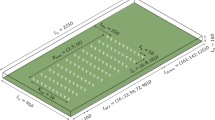Abstract
The objectives of this work are to develop the experimental model of wake behind the wind-power generator rotor to estimate its propagation distance and the impact on the average and pulsation characteristics of incident flow with the possibility of further use of these data in the calculation models of wind and climate changes in the regions and to determine the optimal operation of wind turbines. For experimental modeling, the laboratory model of wind-powered generator with a horizontal axis was used that operated as wind turbine in optimal mode. The kinematic characteristics of flow and changes in the wake structure in the distance of more than 40 rotor diameters downstream with a slight level of turbulent pulsations (less than 2%) of free flow were investigated. A significant impact of external intense pulsations typical for natural atmospheric conditions was purposely excluded in the experimental research in order to define the degree of self-damping of perturbations generated by oneself wind-powered generator. The obtained experimental data for the wake dynamics behind the model of wind-powered generator allowed ascertaining its impact on slowing down of incident vortex flow and determining the distance at which its impact on the stream disappears, and the deceleration values are comparable to the level of pulsations of incident flow. This experimental model with the same degree of damping its velocity and pulsations can be used to adjust the theoretical approximation of the far wake. It is shown that the recovery of velocity of incident flow is faster than has been previously defined in the models of calculating the impact of wind electric power plants on the regional climate changes. Thus, existing wind loss calculated on the model of wake behind the wind-powered generator, adjusted in this study can be even less significant.
Similar content being viewed by others
References
L. Zhou, Yu. Tian, S. B. Roy, C. Thorncroft, L. F. Bosart, and Yu Hu, “Impacts of wind farms on land surface temperature,” Nature Climate Change 2, 539–543 (2012).
R. Vautard, F. Thais, F. Bréon, I. Tobin, J.-G. D. Lavergne, A. Colette, P. Yiou, and P. M. Ruti, “Regional climate model simulations indicate limited climatic impacts by operational and planned European wind farms,” Nature Commun. 5, 1–9 (2014).
V. L. Okulov and G. A. M. Kuik, “The Betz–Joukowsky limit: On the contribution to rotor aerodynamics by the British, German and Russian scientific schools,” Wind Energy 15 (2), 335–344 (2012).
V. L. Okulov, I. V. Naumov, R. F. Mikkelsen, I. K. Kabardin, and J. N. Sorensen, “A regular Strouhal number for large-scale instability in the far wake of a rotor,” J. Fluid Mech. 747, 369–380 (2014).
I. V. Naumov, V. V. Rakhmanov, V. L. Okulov, K.M. Velte, K. E. Maier, R. F. Mikkel’sen, “Flow diagnostics downstream of a tribladed rotor model,” Thermophys. Aeromechanics 19, 171–181 (2012).
I. V. Naumov, R. F. Mikkelsen, V. L. Okulov, and J. N. Sørensen, “PIV and LDA measurements of the wake behind a wind turbine model,” J. Phys.: Conf. Ser. 524, 1–10 (2014).
J. H. Walther, M. Guénot, E. Machefaux, J. T. Rasmussen, P. Chatelain, V. L. Okulov, J. N. Sørensen, M. Bergdorf, and P. Koumoutsakos, “A numerical study of the stability of helical vortices using vortex methods,” J. Phys.: Conf. Ser. 75, 1–16 (2007).
V. L. Okulov and J. N. Sorensen, “An ideal wind turbine with a finite number of blades,” Doklady Phys. 53 (6), 337–342 (2008).
V. L. Okulov, “Testing of rotor vortex theories using Betz optimization,” Doklady Phys. 59 (1), 16–20 (2014).
V. L. Okulov and J. N. Sørensen, “Instability of vortex wakes behind wind turbines,” Doklady Phys. 49 (12), 772–776 (2004).
V. L. Okulov and J. N. Sørensen, “Applications of 2D helical vortex dynamics,” Theor. Compt. Fluid Dyn. 24, 395–401 (2010).
P. B. Johansson, W. K. George, and M. J. Gourlay, “Equilibrium similarity, effects of initial conditions and local Reynolds number on the axisymmetric wake,” Phys. Fluids 15, 603–617 (2003).
P. B. Johansson and W. K. George, “The far downstream evolution of the high-Reynolds number axisymmetric wake behind a disk. Part 1. Single-point statistics,” J. Fluid Mech. 555, 363–385 (2006).
M. A. Ryzhenkov, B. V. Ermolenko, and G. V. Ermolenko, “Environmental problems of wind power engineering,” Therm. Eng. 58 (11), 962–969 (2011).
B. V. Ermolenko, G. V. Ermolenko, and M. A. Ryzhenkov, “Windenergetics and environmental medium,” Energiya: Ekonomika, Tekhnika, Ekologiya, No. 8, 10–19 (2011).
G. V. Ermolenko, I. G. Gordeev, A. V. Nikomarova, M. A. Ryzhenkov, and V. N. Tskhomariya, “Pilot projects of network wind power in the Eisk region of Krasnodar krai: The state and prospects,” Therm. Eng. 59 (11), 846–853 (2012).
M. Bastankhah and F. Porté-Agel, “A new analytical model for wind-turbine wakes,” Renew. Energy 70, 116–123 (2014).
S.-P. Breton, K. Nilsson, H. Olivares-Espinosa, C. Masson, L. Dufresne, and S. Ivanell, “Study of the influence of imposed turbulence on the asymptotic wake deficit in a very long line of wind turbines,” Renew. Energy 70, 153–163 (2014).
V. E. Fortov and O. S. Popel’, “The current status of the development of renewable energy sources worldwide and in Russia,” Therm. Eng. 61 (6), 389–398 (2014). doi 10.1134/S0040363614060022
Author information
Authors and Affiliations
Corresponding author
Additional information
Original Russian Text © I.V. Naumov, R.F. Mikkelsen, V.L. Okulov, 2016, published in Teploenergetika.
Rights and permissions
About this article
Cite this article
Naumov, I.V., Mikkelsen, R.F. & Okulov, V.L. Estimation of wake propagation behind the rotors of wind-powered generators. Therm. Eng. 63, 208–213 (2016). https://doi.org/10.1134/S0040601516030071
Published:
Issue Date:
DOI: https://doi.org/10.1134/S0040601516030071




